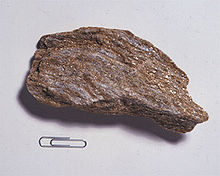- Schist
-
The schists constitute a group of medium-grade metamorphic rocks, chiefly notable for the preponderance of lamellar minerals such as micas, chlorite, talc, hornblende, graphite, and others. Quartz often occurs in drawn-out grains to such an extent that a particular form called quartz schist is produced. By definition, schist contains more than 50% platy and elongated minerals, often finely interleaved with quartz and feldspar. Schist is often garnetiferous.
The individual mineral grains in schist, drawn out into flaky scales by heat and pressure, can be seen by the naked eye. Schist is characteristically foliated, meaning the individual mineral grains split off easily into flakes or slabs. The word schist is derived from the Greek word σχίζειν meaning "to split", which is a reference to the ease with which schists can be split along the plane in which the platy minerals lie.
Most schists have been derived from clays and muds which have passed through a series of metamorphic processes involving the production of shales, slates and phyllites as intermediate steps. Certain schists have been derived from fine-grained igneous rocks such as basalts and tuffs. Most schists are mica schists, but graphite and chlorite schists are also common.
Schists are named for their prominent or perhaps unusual mineral constituents, such as garnet schist, tourmaline schist, glaucophane schist, etc.
Schists are frequently used as dimension stone. Dimension stone is stone that has been selected and fabricated to specific shapes or sizes.
Contents
Historical mining terminology
Before the mid 18th century, the terms slate, shale and schist were not sharply differentiated.[1] In the context of underground coal mining, shale was frequently referred to as slate well into the 20th century.[2]
Formation
During metamorphism, rocks which were originally sedimentary or igneous are converted into schists and gneisses. If the composition of the rocks was originally similar, they may be very difficult to distinguish from one another if the metamorphism has been great. A quartz-porphyry, for example, and a fine grained feldspathic sandstone, may both be converted into a grey or pink mica-schist. Usually, however, it is possible to distinguish between sedimentary and igneous schists and gneisses. If the whole district, for example, occupied by these rocks have traces of bedding, clastic structure, or unconformability then it may be a sign that the original rock was sedimentary. In other cases intrusive junctions, chilled edges, contact alteration or porphyritic structure may prove that in its original condition a metamorphic gneiss was an igneous rock. The last appeal is often to the chemistry, for there are certain rock types which occur only as sediments, while others are found only among igneous masses, and however advanced the metamorphism may be, it rarely modifies the chemical composition of the mass very greatly. Such rocks, for example, as limestones, dolomites, quartzites and aluminous shales have very definite chemical characters which distinguish them even when completely recrystallized.
The schists are classified principally according to the minerals they consist of and on their chemical composition. For example, many metamorphic limestones, marbles, and calc-schists, with crystalline dolomites, contain silicate minerals such as mica, tremolite, diopside, scapolite, quartz and feldspar. They are derived from calcareous sediments of different degrees of purity. Another group is rich in quartz (quartzites, quartz schists and quartzose gneisses), with variable amounts of white and black mica, garnet, feldspar, zoisite and hornblende. These were once sandstones and arenaceous rocks. The graphitic schists may readily be believed to represent sediments once containing coal or plant remains; there are also schistose ironstones (hematite-schists), but metamorphic beds of salt or gypsum are exceedingly uncommon. Among schists of igneous origin there are the silky calc-schists, the foliated serpentines (once ultramafic masses rich in olivine), and the white mica-schists, porphyroids and banded halleflintas, which have been derived from rhyolites, quartz-porphyries and felsic tuffs. The majority of mica-schists, however, are altered claystones and shales, and pass into the normal sedimentary rocks through various types of phyllite and mica-slates. They are among the most common metamorphic rocks; some of them are graphitic and others calcareous. The diversity in appearance and composition is very great, but they form a well-defined group not difficult to recognize, from the abundance of black and white micas and their thin, foliated, schistose character. A subgroup is the andalusite, staurolite, kyanite and sillimanite-schists which usually make their appearance in the vicinity of gneissose granites, and have presumably been affected by contact metamorphism.[3]
Engineering considerations
In geotechnical engineering a schistosity plane often forms a discontinuity that may have a large influence on the mechanical behavior (strength, deformation, etc.) of rock masses in, for example, tunnel, foundation, or slope construction.
See also
References
- ^ R. W. Raymond, Slate, A Glossary of Mining and Metallurigical Terms, American Institute of Mining Engineers, 1881; page 78.
- ^ Albert H. Fay, Slate, A Glossary of the Mining and Mineral Industry, United States Bureau of Mines, 1920; page 622.
- ^
 This article incorporates text from a publication now in the public domain: Chisholm, Hugh, ed (1911). "Petrology". Encyclopædia Britannica (11th ed.). Cambridge University Press.
This article incorporates text from a publication now in the public domain: Chisholm, Hugh, ed (1911). "Petrology". Encyclopædia Britannica (11th ed.). Cambridge University Press.
External links
 Chisholm, Hugh, ed (1911). "Schists". Encyclopædia Britannica (11th ed.). Cambridge University Press.
Chisholm, Hugh, ed (1911). "Schists". Encyclopædia Britannica (11th ed.). Cambridge University Press.- An Examination of Mica Schist by Andrea Samuels, Micscape magazine. Photographs of Manhattan schist.
Categories:- Metamorphic rocks
Wikimedia Foundation. 2010.





